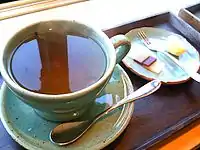Pine needle tea
Pine needle tea or pine leaf tea is a herbal tea made from pine needles, or the leaves of pine trees (trees of the genus Pinus). In Korea, the tea made from the leaves of Korean red pine (P. densiflora) or Manchurian red pine (P. tabuliformis) is known as sollip-cha (솔잎차),[1][2][3] while the tea made from the leaves of Korean pine (P. koraiensis) is known as jannip-cha (잣잎차) or baegyeop-da (백엽다).[4][5] In North America, pine needle tea may be made from the leaves of Eastern white pine (P. strobus).
| Pine needle tea | |
|---|---|
 | |
| Type | Herbal tea |
| Other names |
|
| Origin | Korea |
| Quick description | Tea made from pine needles |
| Temperature | 85–100 °C (185–212 °F) |
| Time | 3‒20 minutes |
| P. densiflora needle tea P. tabuliformis needle tea | |
| Hangul | 솔잎차 |
|---|---|
| Hanja | --茶 |
| Revised Romanization | sollip-cha |
| McCune–Reischauer | sollip-ch'a |
| IPA | [sol.lip̚.tɕʰa] |
| P. koraiensis needle tea | |
| Hangul | 잣잎차 |
|---|---|
| Hanja | --茶 |
| Revised Romanization | jannip-cha |
| McCune–Reischauer | channip-ch'a |
| IPA | [tɕan.nip̚.tɕʰa] |
| Hangul | 백엽다 |
| Hanja | 柏葉茶 |
| Revised Romanization | baegyeop-ta |
| McCune–Reischauer | paegyǒp-da |
| IPA | [pɛ.ɡjʌp̚.t͈a] |
Preparation
Sollip-cha
Sollip-cha is a herbal tea made mostly from the leaves and needles of Korean red pine or Manchurian red pine.[6] Pine needles are usually harvested around December; preferably before midday; from 10 to 20 year-old trees located mid-mountain and facing southeast, that have grown in sunny places.[6] Two types of sollip-cha can be made:
The first method uses fresh or dried pine needles.[6] The harvested leaves are soaked in water for a day and then cleaned, rinsed, trimmed of the sharp tips, and halved or cut into three pieces.[6] They can be used right away or dried in a shaded area before being used. For 60 millilitres (2.1 imp fl oz; 2.0 US fl oz) of water, 10–15 grams (0.35–0.53 oz) of dried pine needles or 20–30 grams (0.71–1.06 oz) of fresh pine needles are infused over low heat.[6] As the tea has the properties of an astringent, honey or sugar is added to improve taste.[6]
The second method consists of using fermented pine needles.[6] The harvested leaves are trimmed of their sharp tips and washed, then placed in a sugar solution made with 600 millilitres (21 imp fl oz; 20 US fl oz) water and 100 grams (3.5 oz) of sugar, which is then fermented in a sunny place for a week (in summer) or more (in other seasons).[6] Well-fermented sollip-cha is filtered with cloth and consumed as cold tea.[6]
References
- "sollip-cha" 솔잎차. Standard Korean Language Dictionary (in Korean). National Institute of Korean Language. Archived from the original on 25 February 2018. Retrieved 9 June 2017.
- "Areumdaun Cha Bangmulgwan" 아름다운차박물관 [Beautiful Tea Museum]. Korea Tourism Organization. 9 March 2010. Retrieved 9 June 2017.
- "Treating disc injuries with traditional Korean medicine". Korea Tourism Organization. 26 April 2012. Retrieved 9 June 2017.
- "baegyeop-cha" 백엽차. Standard Korean Language Dictionary (in Korean). National Institute of Korean Language. Archived from the original on 22 April 2017. Retrieved 21 April 2017.
- "baegyeop-da" 백엽다. Standard Korean Language Dictionary (in Korean). National Institute of Korean Language. Archived from the original on 22 April 2017. Retrieved 21 April 2017.
- 정, 동효; 윤, 백현; 이, 영희, eds. (2012). "sollip-cha" 솔잎차. Cha Saenghwal Munhwa Daejeon 차생활문화대전 (in Korean). Seoul: Hong Ik Jae. ISBN 9788971433515. Retrieved 9 June 2017 – via Naver.
- "baegyeop-cha" 백엽차. Doopedia (in Korean). Doosan Corporation. Retrieved 21 April 2017.
